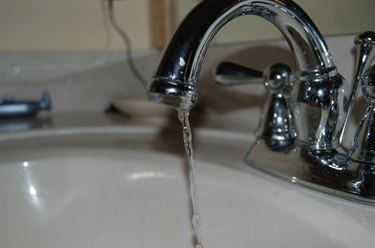Things You'll Need
Tubing cutter
Emery cloth
Flux
Acid brush
Copper fittings
Bladder tank
Thread tape

New quick-closing toilet fill valves can cause water hammer situations in many plumbing systems. Ways to eliminate water hammer after flushing a toilet include installing a permanent water hammer arrestor at the toilet supply, installing a whole house bladder tank at the water heater or individual fixture arrestors in several locations throughout the home. Installing a small, pressure-absorbing bladder tank on the cold water supply of the home's water heater is the best solution. Installing the tank will require some plumbing skill. The experienced do-it-yourselfer should have no problem with the pipe connects required.
Step 1
Turn the main water supply off to the water heater, either at its individual fixture cut-off or at the main house supply.
Video of the Day
Step 2
Cut the copper supply pipe with tubing cutters in a horizontal location. Sand the pipe ends and fittings with emery cloth. Coat the outside of the pipe and inside of the fittings with flux; use a small acid brush. Install a tee fitting facing up. Cut a 2-inch piece of copper pipe and insert it into the top of the tee, and then slip on a female adaptor. Solder all the joints with a torch and lead-free solder. Wipe the joints clean with a rag and allow them to cool.
Step 3
Wrap thread tape around the male threads of the pressure tank several time to insure a watertight connection.
Step 4
Screw the tank onto the fitting by hand.
Step 5
Turn the water back on and check for leaks.
Tip
Always install the tank between the fixture cut-off and water heater. Installing the tank vertically is always the best choice. The bladder tank should be preset to an adequate pressure; however, adjustments my need to be made.
Warning
Not following the manufacturer's instruction could cause personal injury and property damage.
Video of the Day